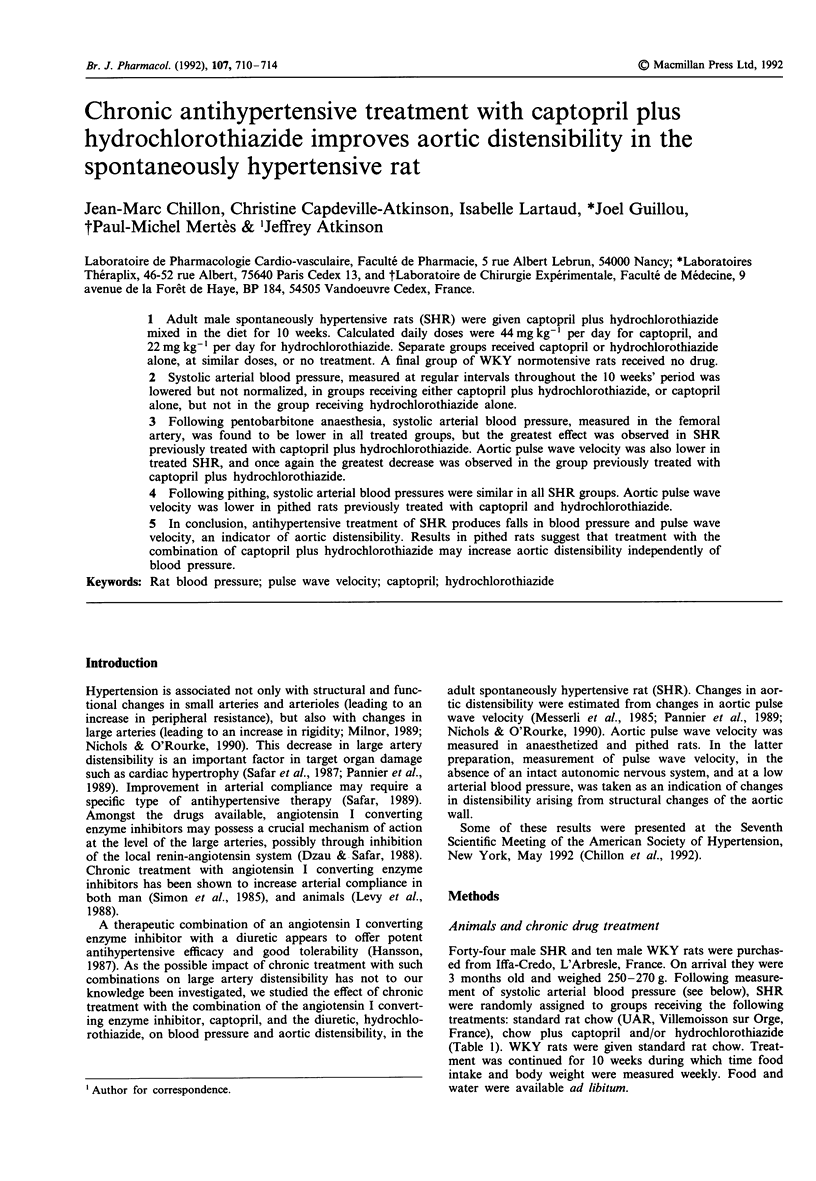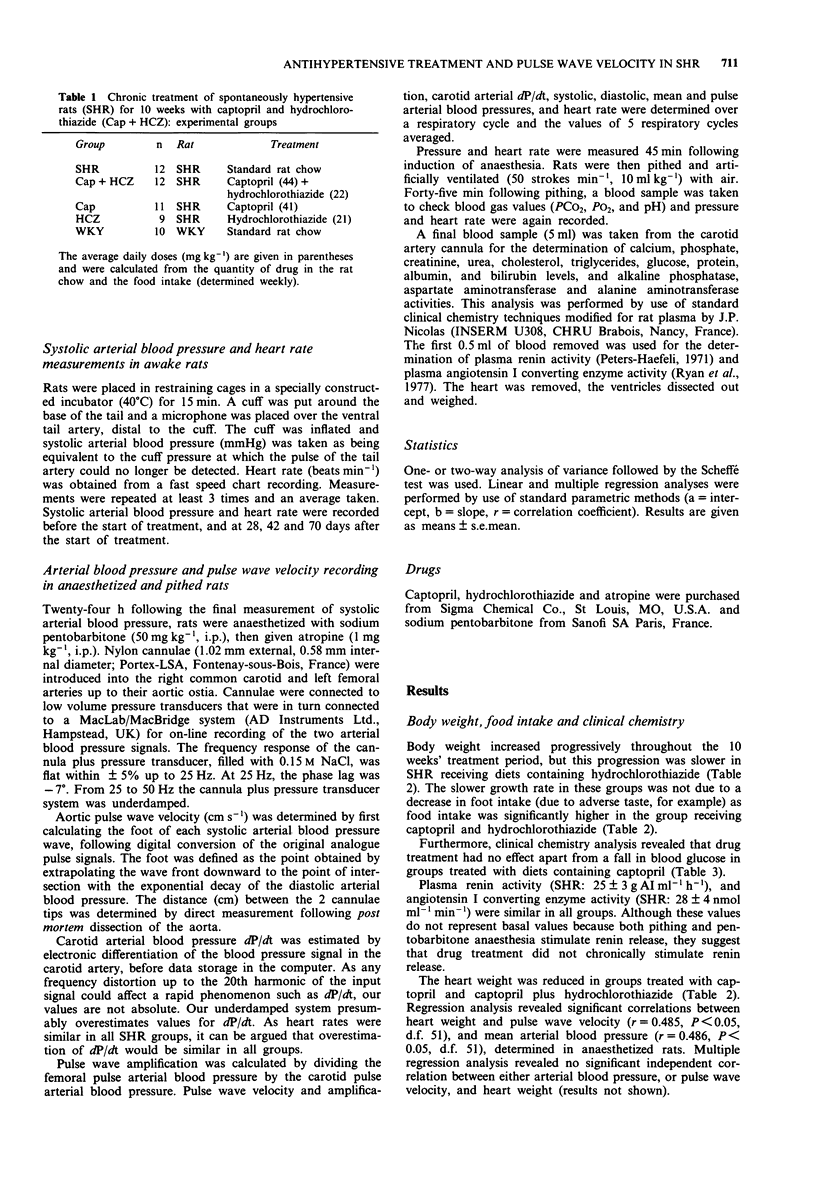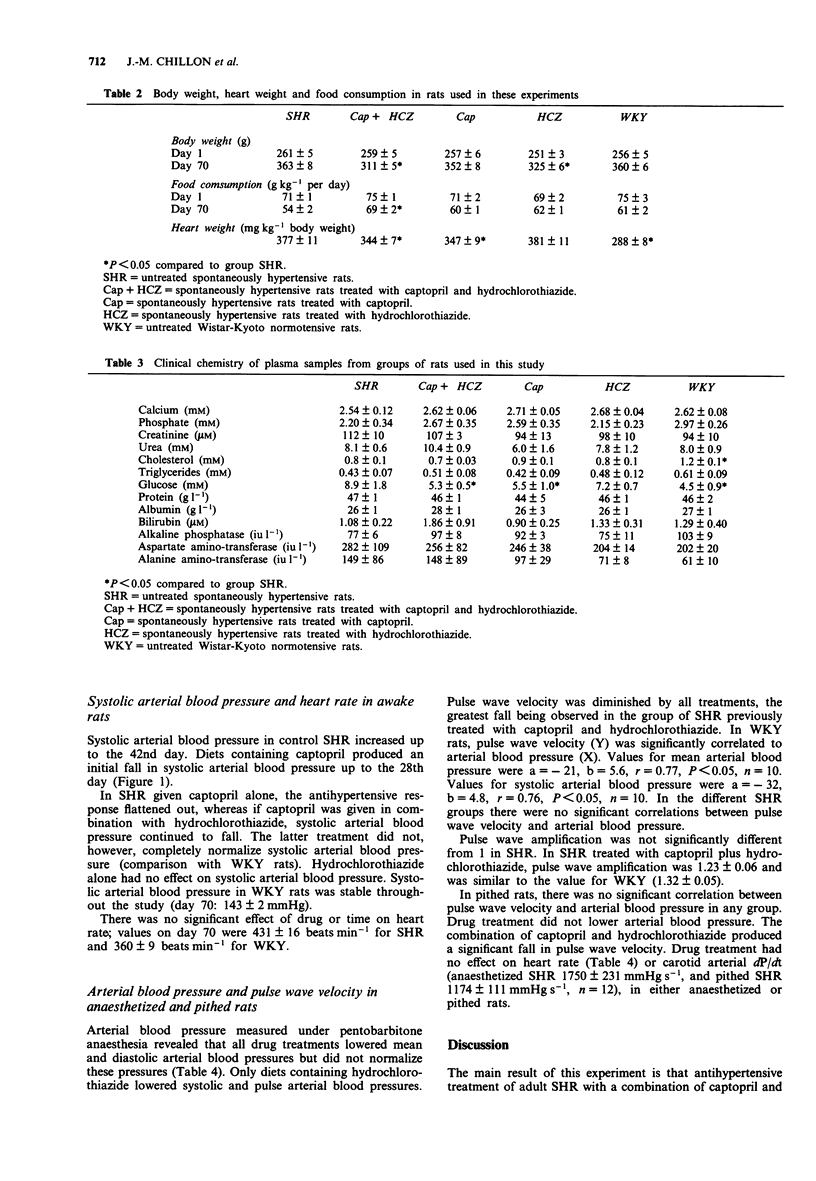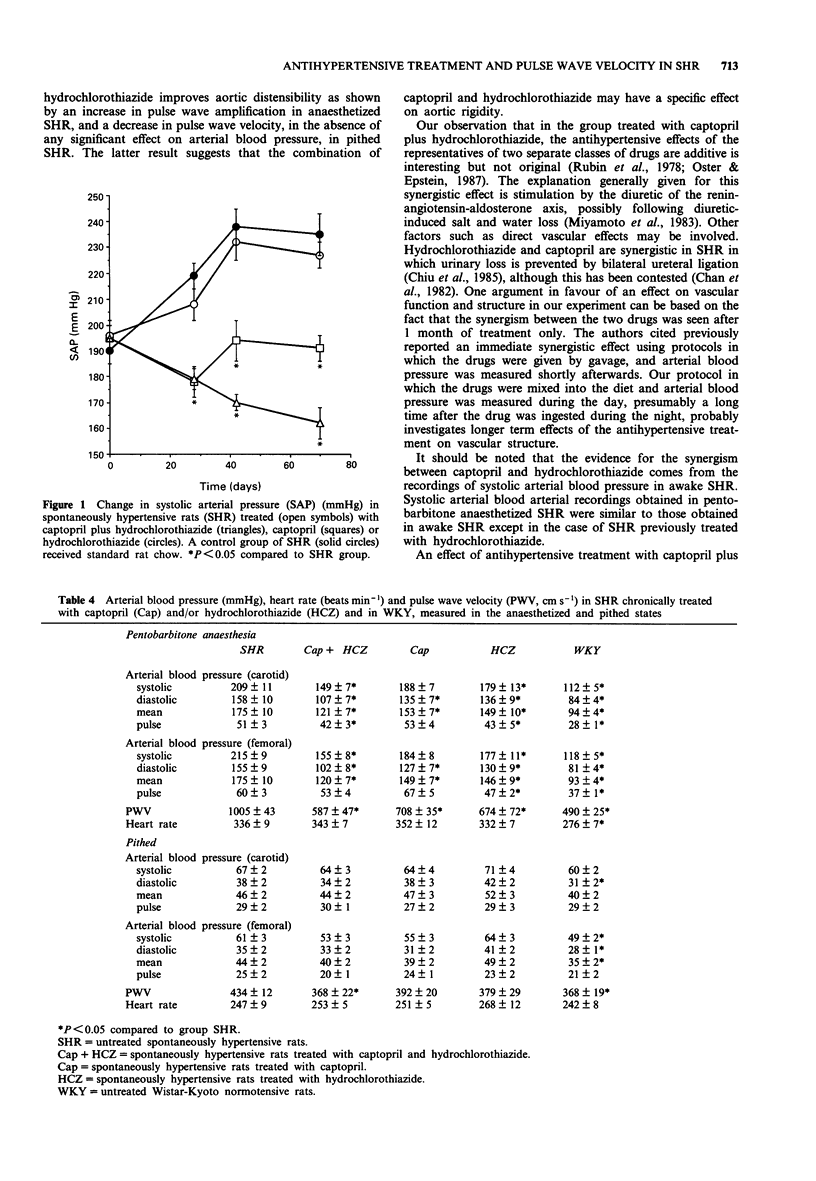Abstract
1. Adult male spontaneously hypertensive rats (SHR) were given captopril plus hydrochlorothiazide mixed in the diet for 10 weeks. Calculated daily doses were 44 mg kg-1 per day for captopril, and 22 mg kg-1 per day for hydrochlorothiazide. Separate groups received captopril or hydrochlorothiazide alone, at similar doses, or no treatment. A final group of WKY normotensive rats received no drug. 2. Systolic arterial blood pressure, measured at regular intervals throughout the 10 weeks' period was lowered but not normalized, in groups receiving either captopril plus hydrochlorothiazide, or captopril alone, but not in the group receiving hydrochlorothiazide alone. 3. Following pentobarbitone anaesthesia, systolic arterial blood pressure, measured in the femoral artery, was found to be lower in all treated groups, but the greatest effect was observed in SHR previously treated with captopril plus hydrochlorothiazide. Aortic pulse wave velocity was also lower in treated SHR, and once again the greatest decrease was observed in the group previously treated with captopril plus hydrochlorothiazide. 4. Following pithing, systolic arterial blood pressures were similar in all SHR groups. Aortic pulse wave velocity was lower in pithed rats previously treated with captopril and hydrochlorothiazide. 5. In conclusion, antihypertensive treatment of SHR produces falls in blood pressure and pulse wave velocity, an indicator of aortic distensibility. Results in pithed rats suggest that treatment with the combination of captopril plus hydrochlorothiazide may increase aortic distensibility independently of blood pressure.
Full text
PDF




Selected References
These references are in PubMed. This may not be the complete list of references from this article.
- Chan P. S., Ronsberg M. A., Cervoni P. Studies on the mechanism of the synergistic antihypertensive activity of captopril and hydrochlorothiazide following acute administration in spontaneously hypertensive rats. Clin Exp Hypertens A. 1982;4(6):1019–1034. doi: 10.3109/10641968209060769. [DOI] [PubMed] [Google Scholar]
- Chiu P. J., Vemulapalli S., Barnett A. Acute blood pressure and urinary responses to single dose combinations of captopril and diuretics in conscious spontaneously hypertensive rats. J Pharm Pharmacol. 1985 Feb;37(2):105–109. doi: 10.1111/j.2042-7158.1985.tb05016.x. [DOI] [PubMed] [Google Scholar]
- Dzau V. J., Safar M. E. Large conduit arteries in hypertension: role of the vascular renin-angiotensin system. Circulation. 1988 May;77(5):947–954. doi: 10.1161/01.cir.77.5.947. [DOI] [PubMed] [Google Scholar]
- Hansson L. Rationale for combination therapy. Br J Clin Pharmacol. 1987;23 (Suppl 1):15S–19S. doi: 10.1111/j.1365-2125.1987.tb03118.x. [DOI] [PMC free article] [PubMed] [Google Scholar]
- Levy B. I., Benessiano J., Poitevin P., Safar M. E. Angiotensin-converting enzyme inhibition and compliance of the carotid artery in normotensive and hypertensive rats. J Hum Hypertens. 1989 Jun;3 (Suppl 1):57–62. [PubMed] [Google Scholar]
- Levy B. I., Michel J. B., Salzmann J. L., Azizi M., Poitevin P., Safar M., Camilleri J. P. Effects of chronic inhibition of converting enzyme on mechanical and structural properties of arteries in rat renovascular hypertension. Circ Res. 1988 Jul;63(1):227–239. doi: 10.1161/01.res.63.1.227. [DOI] [PubMed] [Google Scholar]
- Messerli F. H., Frohlich E. D., Ventura H. O. Arterial compliance in essential hypertension. J Cardiovasc Pharmacol. 1985;7 (Suppl 2):S33–S35. doi: 10.1097/00005344-198507002-00007. [DOI] [PubMed] [Google Scholar]
- Miyamoto M., Koike H., Nishino H. Antihypertensive effects of captopril in combination with diuretics in spontaneously hypertensive rats. J Cardiovasc Pharmacol. 1983 Mar-Apr;5(2):190–193. doi: 10.1097/00005344-198303000-00004. [DOI] [PubMed] [Google Scholar]
- Oster J. R., Epstein M. Fixed-dose combination medications for the treatment of hypertension: a critical review. J Clin Hypertens. 1987 Sep;3(3):278–293. [PubMed] [Google Scholar]
- Pannier B., Brunel P., el Aroussy W., Lacolley P., Safar M. E. Pulse pressure and echocardiographic findings in essential hypertension. J Hypertens. 1989 Feb;7(2):127–132. [PubMed] [Google Scholar]
- Peters-Haefeli L. Rate of inactivation of endogenous or exogenous renin in normal and in renin-depleted rats. Am J Physiol. 1971 Nov;221(5):1339–1345. doi: 10.1152/ajplegacy.1971.221.5.1339. [DOI] [PubMed] [Google Scholar]
- Rubin B., Antonaccio M. J., Goldberg M. E., Harris D. N., Itkin A. G., Horovitz Z. P., Panasevich R. E., Laffan R. J. Chronic antihypertensive effects of captopril (SQ 14,225), an orally active angiotensin I-converting enzyme inhibitor, in conscious 2-kidney renal hypertensive rats. Eur J Pharmacol. 1978 Oct 15;51(4):377–388. doi: 10.1016/0014-2999(78)90429-6. [DOI] [PubMed] [Google Scholar]
- Ryan J. W., Chung A., Ammons C., Carlton M. L. A simple radioassay for angiotensin-converting enzyme. Biochem J. 1977 Nov 1;167(2):501–504. doi: 10.1042/bj1670501. [DOI] [PMC free article] [PubMed] [Google Scholar]
- Safar M. Treatment of hypertension based on both systolic and diastolic pressure could influence the cost of therapy. Cardiovasc Drugs Ther. 1989 Dec;3(6):841–845. doi: 10.1007/BF01869569. [DOI] [PubMed] [Google Scholar]
- Simon A. C., Levenson J. A., Bouthier J., Maarek B., Safar M. E. Effects of acute and chronic angiotensin-converting enzyme inhibition on large arteries in human hypertension. J Cardiovasc Pharmacol. 1985;7 (Suppl 1):S45–S51. doi: 10.1097/00005344-198507001-00010. [DOI] [PubMed] [Google Scholar]


